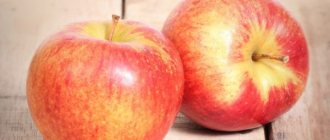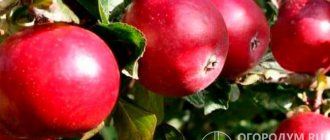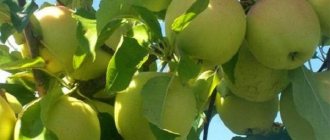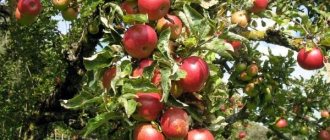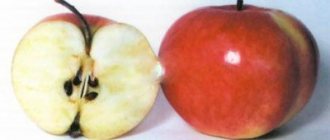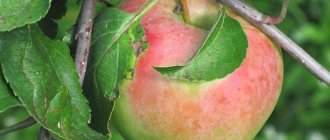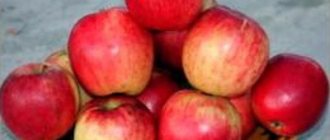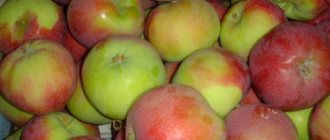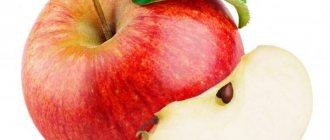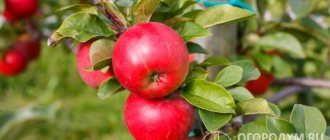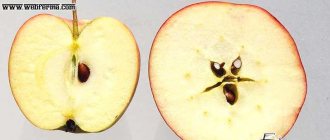Advantages and descriptions of the type
The main characteristic feature of ranetki is the small weight of the fruit, not exceeding 15 g. The small fruits fully ripen in early September and have a pronounced sour taste. Ranetki contains tens of times more bioactive components compared to classic varieties.
Any variety of ranetki is unpretentious in care and grows almost everywhere, while having several features and advantages. The fruits share some of the positive properties of the Siberian apple tree, including resistance to cold, early ripening and stable yield.
Thanks to these qualities, Ranetki are actively used by breeders for crossing with other varieties.
Reviews about the Ranetka apple tree variety
According to reviews from gardeners, the Ranetka apple tree is generally very unpretentious and is suitable for growing almost everywhere except in the polar regions. At the same time, its productivity is high and stable.
Where can I buy
You can buy apple tree seedlings of one of the Ranetok varieties in our online store. We ship orders throughout the country using Russian Post.
Previous:
- Climbing rose Dorothy Perkins: some tips
- Perennials in the garden
- Irga - description, planting and plant care
- Honeysuckle - planting and care, propagation, varieties
- Currants - planting and care, the best varieties
Growing areas
In most European regions, gardeners prefer trees with larger and juicier apples. Ranetki with a pronounced sour taste can often be found in Siberia. Seedlings are able to grow and bear fruit in any climate zone, with the exception of the Far North, where low temperatures do not allow the fruits to ripen fully.
Advantages and disadvantages
Among the undeniable advantages noted by many gardeners, it is necessary to highlight the following indicators:
- high resistance to frost, thanks to which Ranetki apples can be grown in Siberia;
- low maintenance requirements;
- possibility of use for processing;
- unpretentiousness (keeping quality) during storage;
- amicable maturation;
- a large number of fruits.
The disadvantages include:
- the apples are very small;
- sour taste of fruit;
- the growth of trees, which is why large areas are required for cultivation;
- low resistance to diseases and pests.
However, the last drawback does not apply to all varieties.
Taste qualities of apples
The taste of the fruit primarily depends on the characteristics of the variety being grown. Also, the taste characteristics are influenced by environmental conditions, care of seedlings, fertilizers used and climate. Most common varieties have a pronounced sweet and sour taste and insignificant astringency. Some varieties produce juicy apples that are distinguished by their sweetness.
To which regions is the variety more adapted?
Ranetki come from Siberia. Their distribution area is Altai and Krasnoyarsk territories, the Urals, Omsk, Novosibirsk regions and the Far East. Ranetok varieties are winter-hardy and resist scab well. Therefore, they can be seen on private plots of Moscow, Pskov, Kaluga, Ryazan, Penza and other regions. The fruits are used to make compotes and jams. In the southern regions, if these hybrids are grown, it is only for rootstock, since apple trees of more productive varieties are common, whose fruits are large and have good taste.
Ranetka tree is durable and occupies a fairly large area. Therefore, growing it in small summer cottages is impractical.
Frost resistance
The Ranetkas bred by breeders retained some of the positive characteristics of the Siberian apple tree. One of the properties is the ability to endure cold winters at any temperature without leaving a trace. The duration and degree of exposure to cold, as well as the amount of precipitation, do not affect fruiting.
The results of selection experiments confirm that seedlings do not die at temperatures down to -47 degrees. Frosts do not spoil the taste and juiciness of the crop.
The only measure to protect green spaces that may be required during the winter is to wrap the trunk with spruce branches and rags. This will protect the tree trunk from frostbite and rodent attacks.
For Western Siberia
Western Siberia has a continental climate. It is cool here in summer, cold and snowy in winter. Average winter temperatures vary by part of the region. The recorded minimum is 62 degrees below zero. Winters in the center of this region last 7 months, in the north - 9. The main requirement for apple trees growing here is high winter hardiness and early ripening.
Altai beauty
Summer variety. The tree is medium-sized, compact, with a rounded crown. Fruits in the 5th year. The harvest is periodic, 22-28 kg from one tree.
Apples weighing 75-100 g. Round apples are white in color, the top color is streaks and spots of scarlet color. The peel is glossy. Pink juicy pulp, not loose. The taste is dessert. Good transportability. The tree is often grown in its slate form.
Bow to Shukshin
An autumn variety that ripens at the end of August. Fruits in the 4th year of planting. Fruiting is non-cyclical. The tree is medium-sized, the crown is rounded. On average, 15 tons of fruit are harvested from 1 hectare.
The apples are sweet and sour, weigh 85-90 g. Truncated-conical shape. The main color is green. As they ripen, the apples become dark pink, covered with dark streaks. High frost resistance. Storage - a month. The fruits are universal. Scab resistance.
Zavetnoe
Early winter ripening variety. The tree is widespread in Western Siberia. Cold-resistant variety with high immunity. The tree is low, with a sparse crown. Fruits every year - without cyclicity. Apples ripen in September.
The apples are round, medium-sized, weight - 60 g. The skin is white, with red sides. The pulp is crunchy, sour-sweet, with a strawberry flavor. The aroma is weak. The purpose is universal. Storage – 5 months. Practically does not suffer from scab.
Altai amber
Summer self-fertile variety of Siberian selection. Refers to semi-cultures. Medium-sized tree with a rounded crown. Productivity – 20-40 kg per tree, depending on age. Apples ripen in mid-August.
The apples are ovoid, smoothed ribbing. Weight – 50-80 g. The main background is yellow, there is no cover color. The creamy, fine-grained flesh has a good sweet taste. Storage for about a month. Scab resistance. High frost resistance.
Resistance to diseases and pests
Ranetki are especially valued by beginning gardeners for their resistance to infections and harmful insects. As an additional protection against negative impacts, it is recommended to carry out preventive measures in order to increase the immunity of trees.
Primary spraying with urea solution is required before sap flow begins. The procedure repels pests that remain under the bark during the winter. With the onset of summer, Ranetka needs to be worked with Bordeaux mixture. Cracked areas on the trunk are covered with a solution of copper sulfate or garden pitch. During active fruiting, treatments should not be carried out so that substances do not get on the crop.
Video: How to properly trim an apple tree
The procedure is done in the fall after the leaves fall or in the early spring before the sap begins to flow. On mature trees, dry, damaged, old, and unnecessary branches are removed. If you leave a tree to grow on its own, over time it will go wild, lose its appearance, and the fruits will become small and sour.
- Pollinator varieties
At least one apple tree of a different variety is required for pollination. There is no need to select trees specifically. Absolutely all apple trees are suitable. The most common pollinators are white filling and Antonovka.
Lifespan of a tree
Ranetka varieties with periodic fruiting begin to bear their first harvest a year after the seedlings are planted. Subject to regular proper care, optimal climatic conditions and the absence of negative external influences, the lifespan of a tree is several decades. Throughout the entire period of development, the plant bears fruit without losing the taste characteristics of small apples.
Description of the variety
“Ranetka” is the collective name of several hybrids. To breed a small-fruited apple tree, Siberian berry was crossed with European varieties or plum-leaved apple, which is also called “Chinese”. The result was a crop with high productivity, increased winter hardiness, and drought resistance.
The tree grows well, forms a powerful branched skeleton and a wide crown. There are varieties of low growth, with a cone-shaped crown. The crop begins to bear fruit in the 3rd year after planting a two-year-old seedling. I ripen apples every year, but the quantity varies.
They become suitable for consumption in early September. Fruits are stored fresh under proper conditions until February. The apples are small. Average weight 14 g. Color yellow, red. The aroma is rich, the taste is sweet and sour. In general, the taste characteristics depend on the variety of ranetka.
Advantages
- Sustainability. Tolerates frosts below 40 degrees Celsius, heat above +35 degrees Celsius.
- They do not require excessive care or special cultivation conditions.
- It is highly resistant to diseases and pest attacks.
- The fruits do not contain allergens, so ranetka is recommended for baby food. In addition, apples make excellent wine. The variety is in demand among winemakers.
- Abundant fruiting, ripening.
- Apples are extremely healthy. There are 10 times more active substances than in other varieties. Eating fruits is recommended for removing heavy metals and toxins from the body, and destroying pathological microflora.
- The culture is suitable for all climatic conditions. Grows well in the northern regions of the country.
- Long shelf life.
Flaws
Some gardeners note a tart, sour taste.
But this does not prevent you from preparing delicious preserves, jams, jams, compotes, and wine from small apples.
Varieties and their characteristics
Several varieties of ranetki, which differ from each other in a number of characteristics, have become widespread among gardeners. Each variety has the following individual qualities:
- taste;
- fruit size and juiciness;
- features of cultivation and care;
- appearance, color;
- crown width and height (stunted species and trees up to 5 m high are distinguished).
Dobrynya
The Dobrynya variety of ranetki has become widespread due to its resistance to frost and intensive growth. The variety begins to bear fruit later than other varieties - no earlier than 4 years after transplanting into open ground. Dobrynya easily tolerates dry conditions and is immune to scab. From one tree it is possible to obtain about 35-50 kg of harvest.
See also
Description and characteristics of the variety and varieties of Fuji apples, fruiting and cultivationRead
The fruits have a classic sweet and sour taste with a pronounced tart aftertaste. The harvest ripens by the beginning of autumn and can be stored without loss of taste until February. Apple fruits can be frozen because they will retain their juiciness after thawing.
For a long time
The main characteristics of the Dolgo variety are the sweet taste of the fruit with a slight sourness in the aftertaste, fruiting 3 years after planting, the possibility of using the crop as a raw material for making jam or juice. The ranetka variety has average frost resistance. The harvest ripens by early autumn and is stored for a month after harvest. One tree bears about 25 kg of fruit.
Golden
Ranetka Zolotaya is one of the most winter-hardy varieties. The trees reach a height of 7 m and are characterized by intense fruiting. The first harvest is obtained after 3-4 years of growth. Each tree can grow up to 50 kg of apples weighing 10-15 g. Depending on environmental conditions, the crop ripens from mid-summer to September.
The fruits have a yellow peel and dense pulp. The taste of ranetki is sour and tart. The Golden variety is not suitable for long-term storage.
Red
Due to its short shelf life, Red ranetka is used for making purees, compotes and juices. You can harvest from trees of this type the next year after transplanting into open soil.
The fruits ripen at the end of the summer season. Stable fruiting allows for regular harvesting. In appearance, Red ranetka resembles small balls of rich color. The pulp is juicy and creamy, the taste is sour with pronounced astringency.
Laletino
Trees of the Laletino variety have compact sizes and a round, sparse crown. The advantage of the variety is the early ripening of the crop - the first fruits appear 2-3 years after planting. Externally, the fruits look like small ribbed apples with a reddish peel. The soft pink flesh has a dense structure and juiciness.
The shelf life of the Laletino variety does not exceed 2 months, so they should be consumed fresh. Among experienced gardeners, the variety is considered one of the most delicious.
Raspberry
Small apples of the Raspberry variety grow on trees 3 years after planting. The variety is famous for its stable and large harvest, which is harvested in early autumn.
The weight of the fruit is about 10 g, and in appearance they look like a plum. The pulp is juicy and tender with a sweet and sour taste. One of the key advantages of the variety is its long-term storage ability - Raspberry Ranetka does not spoil until spring.
Purple
Among the wide variety, Purpurovaya ranetka is considered the most frost-resistant variety. This species brings a bountiful harvest after 2-3 years from the moment of planting. The fruits are harvested in early September. It is possible to collect up to 50 kg of apples from each tree.
The weight of the fruit does not exceed 10 g, the shape is slightly flattened. The color of the peel is bright red, monochromatic. The pulp has a standard sourish tart taste. Most often, apples are used for processing, since the shelf life is about 2 months.
Siberian
The fruits of the Sibiryachka variety begin to grow after the 3-4th year of tree development. Ranetka of this type is not distinguished by its large harvest, but its quality is not inferior to others. The Siberian is resistant to infectious diseases and is practically not subject to scab.
The spherical fruits weigh up to 20 g. The peel can be yellow or with a red tint. The pulp is juicy with a slight sour taste. If not watered enough, the taste may taste slightly bitter. The harvest ripens by the end of summer and is stored for three months in a cool room.
Flashlight
Trees of the Flashlight variety have a pyramidal shape. Active fruiting begins 3 years after planting. The harvest ripens by early autumn. In one season, up to 20 kg of fruits grow, each of which weighs no more than 15 g.
Ranetki are distinguished by their oval shape, smooth surface and bright crimson peel. During storage, the shade acquires a more saturated color. The taste of the fruit is sweet and sour, there is practically no aroma.
Amber
Ranetka Amber has a long lifespan and actively bears fruit for 3 decades. Tall trees with dense vegetation provide a stable harvest. The weight of the fruit does not exceed 10 g. Apples are yellow in color, spherical in shape and have a smooth surface. Due to its standard taste characteristics, the crop is often used as a raw material for making jam and juices.
See also
How to make a catching belt for an apple tree from pests with your own handsRead
Honey
Tall Honey Ranetka trees with a rounded crown bring a stable and large harvest, which is harvested at the end of summer. Ripe ranetki fall off the branches on their own, which simplifies the harvesting process.
Compared to other varieties, the fruits weigh more, reaching 40 g. The pronounced sweet taste with honey notes allows apples to be used in the preparation of various dishes or consumed fresh.
Dwarf
Despite the compactness of the trees, Dwarf Ranetka bears fruit no less intensely than other varieties. The trees bear bright red fruits with a dense structure and juicy pulp.
The disadvantages of the variety include a short lifespan (2 times less than that of other varieties), as well as the need for better garter due to the many fruits that ripen on thin and fragile branches.
Columnar
The variety belongs to the mid-season category and bears fruit in early autumn. Small juicy fruits have a rich red color and a sour taste. The shape of the ranetki is spherical with pronounced ribbing.
Columnar ranetka requires careful care, including regular watering and fertilizing. If the rules of care are followed, the yield reaches 180 centners per hectare. Throughout the year, trees bear fruit evenly, without a clearly defined periodicity.
Features of growing Ranet
Landing
Key Features
- Ranetki grow well in both sunny and shaded areas, especially since in most cases (excluding dwarf and slate rootstock) the trees themselves will soon outgrow all other species.
- It is not advisable for the tree to be in a draft - this is the only rule that cannot be broken.
- The soil must be fertile, of any acidity, but it is better to decrease it than to increase it. Apple trees take root well in black soil, fertilized loam and even sand.
- They dig holes up to 70 centimeters deep and the same diameter. They can be prepared 2-3 weeks in advance or even in the fall. Soil mixed with fertilizers is poured into the bottom, filled with water, and allowed to stand.
- Before planting, the seedlings are dipped into a “swamp” made of soil and water, but all damaged, rotten or dried roots are first cut off with pruning shears.
- Garter stakes are immediately dug into the holes, which can be removed after 2-4 years.
- The seedling is placed on a layer of drainage (gravel, vermiculite, broken brick), sprinkled with earth, and spilled with a small amount of water so that no air bubbles remain. Continue alternating layers all the way to the surface.
- The root collar of the tree must protrude above the soil surface by at least 5-7 centimeters, otherwise all the properties of the rootstock will be completely leveled.
- Trees should be positioned depending on the selected subvariety. That is, if the height of the proposed tree is 3 meters, then leave the same amount until the next one.
- It doesn’t hurt to mulch the soil on top with chopped straw, grass or humus.
Disembarkation dates
Ranetki are so stable and unpretentious that there is no difference whether to plant them in open ground in spring or autumn. The main thing is to do this in the spring before the buds open, and in the fall - after the final end of leaf fall and sap flow, but no less than a month before the onset of frost.
Protection from frost and rodents
Despite their high resistance, it does not hurt to provide first-year seedlings with protection from low temperatures to ensure their survival. To do this, the trunks are covered with straw sheaves, spruce branches, and wrapped with foam rubber or nylon tights.
To protect them from hungry rodents that move closer to human habitations in winter, you can lubricate the trunks with rendered lard, grease, or special chemical compounds. Insects are repelled by whitewashing with lime in the fall, as well as treatment with insecticides.
Tree care
Loosening the soil, watering: proper agricultural technology
Ranetka loves it when the soil in its root zone is under “black fallow,” that is, dug up. Moreover, the older the apple tree, the wider its trunk circle. For a two- or three-year-old tree, one and a half meters is enough, but an adult tree requires 3-5 meters. Directly near the trunk, the loosening depth is 10-12 centimeters, but already further than a meter you can dig 20-25 centimeters.
Trees do not need special watering, but you should not refuse additional moisture, especially during the dry period. With Ranetki, it is good to adhere to the so-called 10-day rule. It says that if there is no precipitation for a decade, then you need to start watering the apple trees, but if it rains during the next period, then watering can be stopped and exactly 10 days can be counted again.
Pruning: simple crown formation
Most subspecies of Ranetki, if not controlled in any way, can grow up to 7-8 meters, which will significantly complicate their care and harvesting. Moreover, formative manipulations can only be carried out in early spring, before the movement of sap begins. Therefore, you will have to tinker, removing a third of the height of the trunk and all the adjacent skeletal branches that you decided to leave.
Regularly you need to remove all branches that are directed deep into the crown, thicken it excessively, have dried out, or have signs of disease or damage. The cut areas are treated with water-based paint or garden varnish. To rejuvenate 20-30 year old apple trees, 2-3 age-old shoots are removed, leaving “tops” - well-developed fatty branches.
Pollinators
- Chinese.
- Celeste.
- The hero of the day.
- Melba.
- Silver hoof.
- Candy.
Reproduction
- Layers (clones).
- Growing from seeds.
- Grafting with cuttings and buds.
Diseases and pests
- Scab.
- Powdery mildew.
- Fruit rot.
- Cytosporosis.
- Leaf roller.
- Green Aphid.
- Apple codling moth.
Optimal care for good growth and harvest
To get a large harvest of ranetki, you must adhere to some rules for caring for seedlings. In particular, trees require:
- Regular watering. The soil in the tree trunk circle must be constantly moistened.
- Fertilizer application. Fertilizing ensures intensive growth and affects the abundance of the harvest.
- Crown trimming. With heavily dense vegetation, the amount of yield may decrease.
- Protection from pests and diseases. Spraying plantings with insecticidal and fungicidal preparations helps preserve the quality of the crop.
- Garter. To prevent seedlings with fragile and thin trunks from breaking due to exposure to precipitation or wind, it is necessary to securely fix them on the site.
In order to promptly detect problems in tree development, it is recommended to constantly inspect the plantings . If traces of pests or diseases are noticed on the wounds, it is necessary to treat the seedlings and create favorable environmental conditions.
Beneficial properties of apples and contraindications
Due to their relationship with the wild apple tree grown in harsh Siberia, ranetki contain a large amount of useful substances necessary to support health and well-being. Special enzymes present in apple pulp strengthen the immune system, normalize water-salt balance and stimulate metabolic processes in the human body.
Chemical composition
Miniature fruits have an unusual taste and bright aroma due to the combination of high molecular weight carbohydrates, essential amino acids and essential fiber. 100 grams of apples contain:
fats - 0.3 grams;
- proteins - 0.4 grams;
- organic acids - 0.7 grams;
- carbohydrates - 10 grams;
- ash - 0.4 grams;
- plant fibers - 1.9 grams;
- water - 86.5 grams.
The composition of healthy fruits also includes vitamins, minerals and chemical components necessary for the normal functioning of all organs and systems:
- essential amino acids (tryptophan, lysine, arginine, methionine, phenylalanine);
- digestible carbohydrates (glucose, fructose, starch, sucrose);
- nonessential amino acids (alanine, glycine, serine, cysteine, glutamic acid);
- vitamins (B1, A, K, C, E, B6, H, B2, B9);
- macroelements (phosphorus, chlorine, magnesium, calcium, sodium, potassium, sulfur);
- trace elements (iron, chromium, iodine, zinc, manganese, copper, fluorine, aluminum, boron, cobalt).
Substances contained in the pulp of the fruit help break down fat in the human body, speed up metabolism, and improve the appearance of skin, hair, and teeth. Tart apples also have a beneficial effect on the condition of blood vessels, making them more elastic, and help fight viral, colds and infectious diseases.
Advantages and disadvantages of fruits
Thanks to the vitamin composition, ranetki can have a beneficial effect on the health of children and adults. Their regular use can affect the body in the following ways:
- The functioning of the heart is stabilized, the blood vessels are cleared of cholesterol deposits, and become stronger and stronger.
- The activity of the digestive system is normalized, toxic and harmful substances are eliminated.
- Performance improves, thought processes are activated.
- Metabolism accelerates, which contributes to the disappearance of extra pounds.
- Blood pressure returns to normal.
- Liver function is stabilized and the risk of duodenal diseases is reduced.
- Bone tissue is strengthened, the condition of the skin and mucous membranes is improved.
Healthy fruits contain tannin compounds, which have a positive effect on appearance, elevate your mood and tone the entire body. And thanks to the high content of vitamins, apples help in the fight against vitamin deficiencies and improve visual acuity.
Unfortunately, from excessive consumption of ranetki or individual intolerance to the fruit, unpleasant symptoms of the following nature may occur:
- Allergy.
- Urinary dysfunction.
- Gastritis.
- Increased sensitivity of tooth enamel.
- Colitis, diarrhea.
- Epilepsy attacks.
A painful reaction can only occur in people who initially have health problems, so before introducing fruits into your diet, you should consult your doctor and make sure they are harmless.
Planting and care conditions
It is recommended to transfer ranetka seedlings to open ground before sap flow begins in March or autumn. For trees, a hole with humus is dug in advance and a stake is inserted for tying.
It is necessary to place the seedling in the hole in such a way that the top of the root system remains above the soil surface. To ensure that the roots are firmly fixed in the soil, abundant watering is required immediately after sprinkling with soil.
Crown formation
After the second year, the formation of the tree crown is required. Pruning is carried out after the leaves fall or in early March before the onset of active growing season. Dried and old branches must be removed from the crown.
It is also recommended to cut young shoots directed at an acute angle to the trunk, which will protect the branches from breaking under the weight of the apples. In the absence of shelter formation, the tree will produce a small harvest.
Reproduction
It is possible to increase the number of trees on a site in various ways. The easiest way is to plant the seeds in open ground and wait for inputs. Due to its natural vitality, the seedling grows with minimal care.
Reproduction can also be done through grafting. To do this, some of the ranetka branches are grafted onto other apple or wild apple trees. In this case, you will not need to look for a new place to plant seedlings, while increasing the amount of harvest.
Video: Grafting a wild apple tree
The young plant develops well and grows quickly.
- Agricultural technology
To preserve moisture in the soil and prevent the proliferation of pest larvae, the root circle is mulched. For these purposes, choose dry soil, grass, hay, and sawdust. Young seedlings must be tied up. In the spring, the trunks are treated with lime to prevent diseases and insect pests.
- Top dressing
Ranetki grow on any soil, but regular fertilizing must be present if the soil consists entirely of sand, clay, or has an acidic composition. Wood ash, potassium sulfate, superphosphate, and humus are chosen as top dressing. Too frequent feeding is not required. It is enough to fertilize the soil twice during the growing season.
- Trimming
In the second year of crop growth, crown formation begins. Remove branches located at an acute angle relative to the trunk.
Ripening and fruiting period
Most varieties of ranetki begin to bear fruit in the second year of tree development. Flowering occurs in late spring or early summer. The exact timing depends on the characteristics of the variety and climatic conditions. The duration of flowering can reach 10 days.
The trees begin to actively bear fruit, subject to regular care and suitable weather. There are varieties that bear fruit periodically - the harvest of such trees ripens every year.
When the fruits ripen
Common types of ranetkas bear fruit at the end of the summer season or the beginning of autumn. Late-ripening varieties fully ripen in October. In order to always have a fresh harvest, experienced gardeners plant different varieties on plots, which differ in ripening time and storage duration.
The harvest volumes from each tree vary from 20 to 70 kg depending on the variety. Winter cold does not affect the fruiting of most types of ranetki.
Additional characteristics of the plant
In the garden plot, the raneta can be seen from afar. The tree of impressive size attracts attention in the spring with its abundant flowering, and in the summer with a huge number of small apples.
- Tree height, crown width
Ranetki are large apple trees. The height of the tree reaches 7 meters. The crown is oval, spherical, spreading. The branches are massive. One crop requires a plot of 5*5 meters. The culture grows quickly, reaching its maximum height after 3 years.
The exception is hybrid low-growing varieties - dwarf, whose height is no more than 3 m. The shape of the crown is very different from the columnar ranetka, which does not have a spreading, branched skeleton. The shoots are neat, directed upward along the main trunk.
- Frost resistance
The apple tree tolerates frost and the harshest winters well. The ancestors of ranetki are wild animals and can withstand temperatures as low as -47 degrees Celsius. The degree of cold weather and its duration do not affect the yield. Apple trees are not wrapped or insulated for the winter. The only care is to wrap the trunk with spruce branches and rodent rags. It is worth noting that young seedlings are less resistant to cold, so they need to be insulated before frost.
- Diseases, pests
There is conflicting information regarding the ranetka's immunity to diseases and pest attacks. Some experts note high resistance, others talk about mandatory preventive spraying. The first treatment with urea solution is carried out in early spring, before the start of sap flow.
The product destroys pests that have overwintered under the tree bark. It is recommended to treat cracks with garden pitch or copper sulfate. In summer, you should spray the tree with Bordeaux mixture. During the period of fruit ripening, the use of products is not allowed.
- Productivity
The apple tree bears fruit every year, but the number of fruits varies. A bountiful harvest is harvested every 2 years. One mature tree can produce up to 100 kg of fruit. Drought and severe winter do not affect productivity. Depending on the variety, fruits ripen in August-September.
- Plant lifespan
Currently reading: Chaenomeles: beneficial properties, how to grow Japanese quince
A full harvest is harvested in the third year of tree growth after planting a two-year-old seedling. The lifespan of a Ranetka is calculated in decades. You can be confident that the apple tree will bear fruit for 20-30 years, depending on climatic conditions and care. This is one of those trees that remains on the site for descendants.
